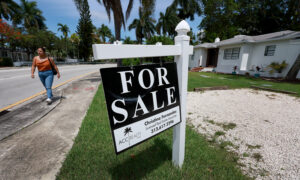
Despite the national slump in real estate sales, Lawrence Yun, the chief economist at the National Association of Realtors (NAR), is forecasting that mortgage rates will fall closer to 6.0 percent by the end of 2023 and go below 6.0 percent in 2024. He expects new and existing-home sales to bottom out in 2023 before an upturn in 2024.
During the “Residential Economic Issues and Trends” forum at NAR’s recent legislative meetings in Washington D.C., Yun also disclosed that the Federal Reserve’s most recent rate hike was unnecessary, and he expects the Fed will stop raising interest rates further.
Yum blamed the Fed’s aggressive rate hikes for hurting the real estate market as well as regional makes, noting that inflation has already started to relax. “Inflation will not reignite—inflation will come down closer to 3 percent by the year’s end,” he said. “Inflation has calmed down while rents are still accelerating.”
Yun added that new home sales are back to pre-pandemic levels, but existing-home sales are historically low. Currently, housing inventory is down 40 percent compared to 2019. “We have to stop the bleeding before improvement takes place,” he said. “We need to get more inventory, and the long-term solution is more home building,” he said.
On that note, the current national median existing-home sales prices is 388,000, down 1.7 percent from last year (April 2023 data). Low inventory combined with persistently higher mortgage rates are continuing to discourage current homeowners from selling, amid worries of what they will be able to find and what their mortgage payments will be under those higher rates.
Jennifer Folk, a mortgage professional with Minute Mortgage in Scottsdale, Arizona, has been in the industry for over 20 years. “I’ve seen a lot of highs and lows over the years, but I do think we’ll see rates land somewhere around 5.5 percent by the end of the year or into the first quarter of 2024,” she told The Epoch Times. “I definitely think people will get a little more breathing room by that time.”
Market Fluctuation Ahead
With the current national average hovering around 7.2 percent for a traditional 30-year loan, Folk indicated the market may continue to fluctuate over the next few months. “The rates also depend on a lot of factors, such as the amount of a down payment, credit score and if someone is a first-time homebuyer considering an FHA loan,” she said. In that case, a potential homeowner may qualify for a lower rate or if someone is veteran, he or she can apply for a Veterans Administration loan.
While Federal Housing Administration (FHA) loans require a lower down payment than conventional loans, the FHA model does have upfront premiums. For example, a conventional loan for $350,000 home with a 5 percent down payment of $17,500 would result in the homeowner borrowing $332,500. The mortgage rate would vary depending on the current state of the market.
With an FHA loan and a 5 percent down payment on that same $350,000 house, the borrower would be required to pay an additional $5,818.75—a 1.75 percent upfront charge on the loan amount of $332,500. On the upside, the interest rate would be lower than with a traditional loan.
“However, any borrower who is making a down payment of less than 10 percent will also be required to pay private mortgage insurance [PMI],” Folk explained. “With an FHA loan, the PMI payments will end after 11 years.”
Low housing inventory across the country continues to be problematic. “I think it will take a lot more entry-level housing to get things moving again,” added Folk. “Condos and townhouses tend to be more affordable options for first-time homebuyers.”
One trend starting to expand in the West is “Next Gen” housing, which are single-family homes with accessory dwelling units for aging parents or children who cannot yet afford to purchase on their own. “I think a lot of builders have been fearful about over-building, but in this market, I don’t think this will be an issue,” Folk said. Resort communities for the 55-plus market are also expanding in Arizona and other sections of the country.
Low Inventory
Sheetal Sawhney, branch manager of CrossCountry Mortgage in North Bergen, New Jersey, agrees that signs are pointing to lower rates in late 2023 and early 2024. “When inflation comes down, you’ll see the rates come down and hopefully that will help to jump-start the real estate market again,” she told The Epoch Times.
Sawhney has been in the mortgage business for almost 25 years and is licensed in New York, New Jersey, Connecticut, Pennsylvania, Florida, and Georgia. As in many parts of the country, the inventory is also exceptionally low in the New York metropolitan area. “A lot of my clients who have been pre-qualified for loans are frustrated when they are outbid for a home,” she said. “It’s disheartening for them.”
As a result, some are opting to move further from the area to find more affordable homes and less competition. Sawhney has seen many New Yorkers moving to New Jersey, while New Jersey natives often choose Pennsylvania.
Lower mortgage rates for the fourth quarter of this year could mean those homeowners who are now “on the fence” may give some more thought to selling. “People who have a 3 or 4 percent rate now probably won’t want to sell in this current market,” she explained. “But rates at 6 percent or below could change their minds. After all, going from 4 to 5.5 percent is a lot better than 4 to 6.5 percent.”

















































